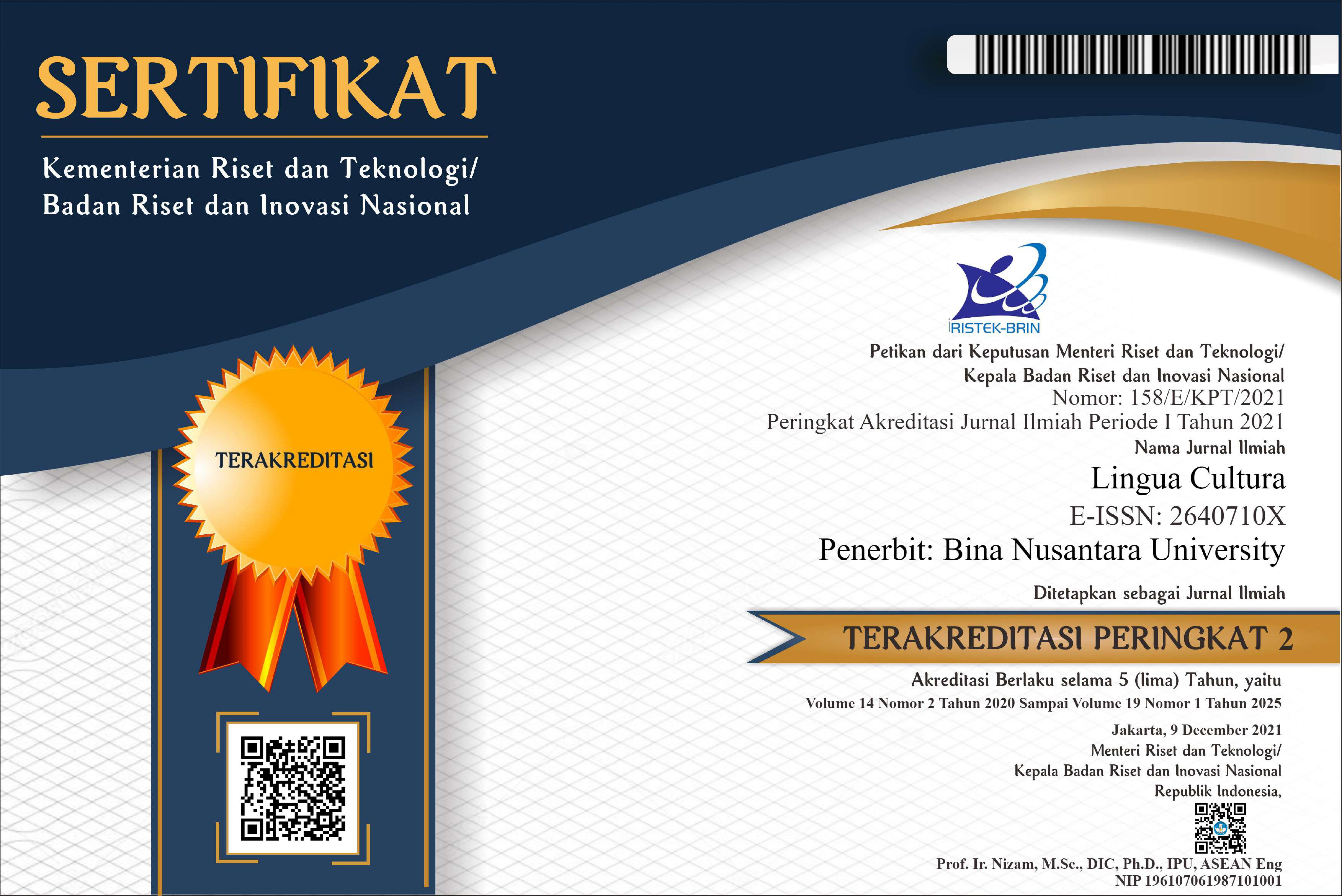Stylistic Analysis of Maya Angelou’s Equality
DOI:
https://doi.org/10.21512/lc.v11i2.1602Keywords:
stylistics, poem, language, freedomAbstract
This research presented the stylistic analysis of a poem by Maya Angelou, Equality. The poem was chosen as it became Angelou’s one of well-known poems. The Stylistic analysis aimed at comprehending the meanings of either literary or non-literary text by means of observing the language device used in the texts. In this article, the stylistic analysis was conducted to analyze Maya Angelou’s Equality. To achieve the goal of stylistic analysis, there were some language levels to observe; they were phonological, graphological, grammatical, and semantic levels. In the phonological level, the repetition of rhyme in some stanzas, assonance, consonance, and alliteration were used to voice Angelou’s dream about freedom for black people. In the graphological level, the use of prominent punctuation in stanzas 3, 6, and 9 stressed equality as the requirement for the freedom she expected. In the grammatical level, Angelou used pronoun I and you as the dominant words in the poem, revealed different class the poet experienced in the country. The use of metaphors in the poem brought the same meaning as freedom, voice, effort, and racism that black people experienced in America. This research concludes that stylistics applies to analyze literary work so that thorough appreciation to it can be achieved.
Plum Analytics
References
Al Shawa, Wisam. (2015). Stylistic Analysis of the Poem “To A Skylark” by P.B. Shelley. Journal of Humanities and Social Science, 20(3), 124-137.
Aslam et.al. (2014). Stylistic Analysis of the Poem “Bereft” by Robert Frost. European Journal of Researct and Reflection in Arts and Humanities, 2(1), 1-5.
Batool et.al. (2014). Stylistic Analysis of Robert Frost’s Poem: “The Road Not Taken”. Journal of ELT and Applied Linguistics, 2(4), 52-64.
Bradford, Richard. (2005). Stylistics: The New Critical Idiom. New York: Routledge.
Hillier, Hillary. (2004). Analyzing Real Texts: Research Studies in Modern English Language. New York: Palgrave MacMillan.
Hanif et.al. (2015). A Stylistic Analysis of William Henry Davies’ “Leisure”. Journal of Literature, Languages and Linguistics, 7, 30-36.
Isti’anah, Arina. (2013). Language Features for More Understanding Literary Work. The 1st Literary Studies Conference.
Isti’anah, Arina. (2015). Transitivity Analyses in Literary and non-Literary Texts: for Truth and Meaning. English Language Studies for Truth and Meaning, 63-78.
Shaheen et.al. (2015). Stylistic Analysis of the Poem “The Red Whel Barrow” by William Carlos William. European Journal of English Language and Literature Studies, 3(5), 36-39.
Simpson, Paul. (2004). Stylistics: A Resource Book for Students. New York: Routledge.
Verdonk, Peter. (2002). Stylistics. Oxford: Oxford University Press.
Downloads
Published
Issue
Section
License
Authors who publish with this journal agree to the following terms:
a. Authors retain copyright and grant the journal right of first publication with the work simultaneously licensed under a Creative Commons Attribution License - Share Alike that allows others to share the work with an acknowledgment of the work's authorship and initial publication in this journal.
b. Authors are able to enter into separate, additional contractual arrangements for the non-exclusive distribution of the journal's published version of the work (e.g., post it to an institutional repository or publish it in a book), with an acknowledgment of its initial publication in this journal.
c. Authors are permitted and encouraged to post their work online (e.g., in institutional repositories or on their website) prior to and during the submission process, as it can lead to productive exchanges, as well as earlier and greater citation of published work.
USER RIGHTS
All articles published Open Access will be immediately and permanently free for everyone to read and download. We are continuously working with our author communities to select the best choice of license options, currently being defined for this journal as follows: Creative Commons Attribution-Share Alike (CC BY-SA)

















